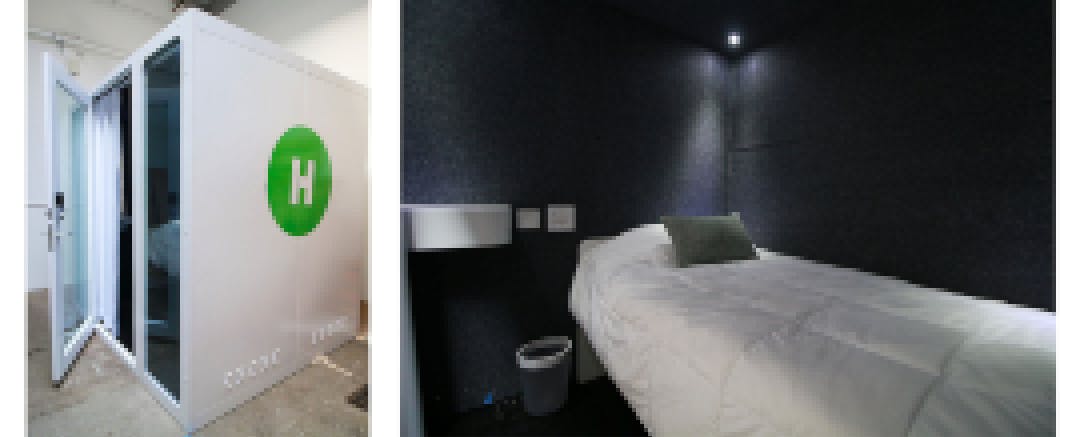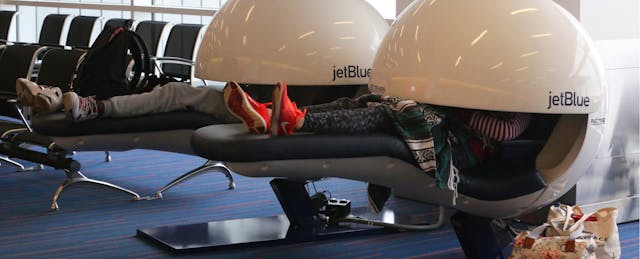Around this time of the school year, it’s not uncommon to see sleep-deprived students slumped over library desks studying late hours in preparation for final exams.
As wellness and anti-stress campaigns become more popular on college campuses, some institutions are responding by giving students a more comfortable place to catch some z’s: in space age-looking sleep pods.
Already a handful of colleges and universities—and even high schools—have made room for the devices, which can go for anywhere from $8,000 to $13,000. The University of Miami, Wesleyan University, Stanford University, Washington State University and more have all debuted sleep pods in libraries, health centers and other spots on campus.
In 2017, the University of Florida installed two “EnergyPods” from Denmark-based MetroNaps, whose sleep pods were made popular after Google purchased the devices for its employees to take naps at work. Melissa L. Rethlefsen, associate dean of the George A. Smathers Libraries at University of Florida, has a clear view of the futuristic egg-shaped pods from her office in the university’s Health Science Center Libraries. The sleep chair comes with a soundtrack that is supposed to soothe parts of the brain to promote relaxation. (The jury is still out if this trendy wellness technology works beyond a placebo effect.)
“I can see people in them now,” she told EdSurge in a phone interview this week. “They are in very high demand by students.”

Rethlefsen said the pods were brought in to supplement a suite of wellness initiatives the campus offers to help students relax and promote mental health. “There is a major challenge among health science students with severe burnout and depression and mental health issues,” she said. “We see the library as a place to promote wellness and wellbeing, a place of rejuvenation, and this is one of the ways we try to provide that service.”
Similar rationale is used to justify the pricey nap spaces over at Texas A&M University at Corpus Christi. Franklin Harrison, director of recreational sports, goes as far to say there is a “sleep crisis” on campus and that health experts were looking for ways to promote sleep health when they purchased their own tubular sleep device in 2014.
“From a holistic wellness standpoint, we look at some of the latest issues on campus with sleep deprivation,” says Harrison. “It’s not thought about enough when you talk about class performance or athletic performance when you think about the overall well-being of a student.”
Students at Texas A&M sign-up to reserve the sleep pod for 30-minute or 1-hour naps, and officials can see that data to monitor how often and when the devices are being used. Harrison said around 57 students used the pod last semester, and those users often returned for multiple sessions.
For all the hype, many people aren’t shy to critique the high cost of these devices, and question whether purchasing these expensive gadgets skirt underlying issues around why students are sleep deprived in the first place.
At the University of California, Los Angeles, a proposal to buy up to 11 sleep pods to campus was shot down after students deemed the device—which was estimated to cost in total between $30,000 and $45,000 to purchase and install—to be not financially unfeasible.
“That money wouldn’t be used as efficiently as it could be,” one student told the Daily Bruin.
Another sleep pod company on the horizon is hoping to address cost concerns by dropping sleep pods onto campuses for free—and instead rely on a paid advertising model.
San Diego, Calif.-based HOHM looks more like a tiny bedroom than a sleep pod. The 43.5 square-feet “devices” come equipped with a twin-sized bed, chargers, privacy curtains and a tablet. According to CEO Nik Woods, the plan is to give colleges and universities up to four sleep stations for free, and for each student to receive two free hours per month to snooze. Anything beyond that schools or students have to pay for.

His plan is to rely on corporate advertisers to foot the bill. Companies like Tempur-Sealy might plant their mattress in the pod, he explained, and students can look on the tablet for information about the products they are using. “We give them a taste of a product and ideally they like it and want,” Woods said.
The CEO said HOHM will not share students’ emails, which are used to sign up for sessions in the sleep pod, with its corporate partners. But students will likely receive a follow-up thank you email that would include information about the products in the room.
Like its sleep pod competitors, HOHM is targeting co-working spaces and corporate offices, alongside colleges and universities. And the company is set to deploy its first pod at the University of Arizona this December. That might come as a surprise to students, though. When EdSurge contacted the student body president to ask about the pods, she said it was the first time she heard they are heading to campus.
By having a closed door, HOHM’s sleep pod avoids another concern Rethlefsen, the associate dean at University of Florida, said students have about the sleep chairs: “Some people don't feel comfortable being that relaxed in a public space.”
In her previous role at the University of Utah, she said officials were looking into the sleep pods but decided against it after concerns that covering students’ heads but leaving the rest of their body and belongings exposed could leave students vulnerable to assault or theft.
What HOHM may not be able to get over, however, is a perceived gross factor. Both Harrison and Rethlefsen say the most common complaint they hear from students is fear that the devices are dirty or unhygienic, even though the pods at both universities are cleaned regularly.
That concern appears off-campus as well. After the JetBlue terminal at John F. Kennedy International Airport introduced sleep pods, the New York Post reported that cleanliness was one major reason why some travelers wouldn’t try it.
Still, Harrison stands by the pods. “Critics would say it’s a bandaid solution, but… if you can make people realize that sleep plays a key role in brain function, then it’s done it’s job. I will take the criticism if we are making a difference.”


